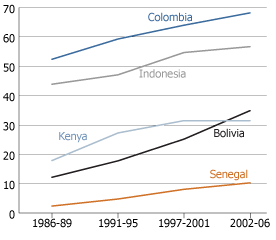
Family Planning Worldwide 2008 Data Sheet
Date
March 18, 2008
Author
- This data sheet also in French and Spanish.
Demand for Family Planning Is Rising
(March 2008) The worldwide demand for family planning services is growing because of two trends: the burgeoning numbers of young people entering childbearing age and the increasing adoption of contraceptive use. “Either trend would lead to greater demand,” said Toshiko Kaneda, co-author of the Population Reference Bureau’s new data sheet, Family Planning Worldwide 2008, “but the two acting together mean there are likely to be huge increases in the future.” This PRB data sheet presents information about women, fertility rates, and contraceptive methods used in more than 150 countries. It was prepared by Donna Clifton, Toshiko Kaneda, and Lori Ashford.
The growth will be especially strong in some countries. The new data sheet shows that the number of women ages 15 to 49, the primary audience for family planning services, will jump 30 percent, from 8.9 million to 11.6 million, between 2005 and 2015 in Tanzania, for example. However, the number of women using modern contraception will grow more, by 90 percent. In Peru, where use is already high and not projected to increase as much, the number of modern contraceptive users will grow from 3.7 million to 4.5 million, primarily because of population growth.
How sure can we be that these increases will occur? The number of women of reproductive age is easy to project to 2015: They are already born. It is trickier to project the percentage of women using contraception, because that assumes we know what choices women and couples will make in the future. At least two signs suggest contraceptive use will increase. First, many women who do not now use family planning say they would like to control the number and timing of their children. In sub-Saharan Africa, about one-quarter of the married women of reproductive age fall into this category. They could constitute a large population of users if modern contraceptive methods become more easily accessible.
Second, contraceptive use has increased in nearly every country in recent decades, whether they started at a very low level (as with Senegal) or a relatively high level (as with Colombia) (see figure). The magnitude and path of the increase are harder to forecast. The change can be rapid (as in Bolivia), slow (as in Senegal), or rise rapidly and then level off (as in Kenya). While the amount of the increase may not be certain, the number of women who need contraceptive services and supplies is sure to rise because of the concurrent increases in population and contraceptive use rates.
Percent of Women Using Family Planning, Late 1980s to Early 2000s, Selected Countries

Source: Donna Clifton, Toshiko Kaneda, and Lori Ashford, Family Planning Worldwide 2008
(Washington, DC: Population Reference Bureau, 2008).
Mary Mederios Kent is senior demographic editor at the Population Reference Bureau.
